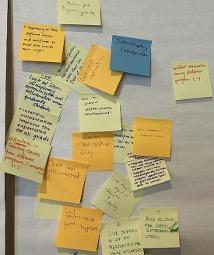
Blog
Promoting Interdisciplinary Collaboration and Communication at Duke
It was the random shuffle of our Emerging Leaders Institute (ELI) name tags that brought our unique team together from the disciplines of genetics, physics, and political science. It quickly became clear that not only our team, but those in the ELI around us, all come from different backgrounds, with different interests and varying disciplines. We quickly began talking about grad school life, the hurdles of publishing in our respective fields, and our efforts to establish work-life balance through our interests like snowboarding and running. We realized that, if it wasn’t for the ELI, despite brushing shoulders on campus, we really wouldn’t have gotten to know each other, or the disciplines we represent.
But this isn’t uncommon! From the perspective of graduate students and postdocs with distinct focuses, we tend to think of studying the physical and social world through the lens of different disciplines. For example, genetics is the study of genes, heredity, and evolution, physics examines the fundamental components of matter, and political science is concerned with, well, politics. Given the boundaries that exist between disciplines, it is easy for us, as students and as researchers, to have too great a focus on our chosen field. We risk, in other words, becoming siloed.
An interdisciplinary approach cuts across these barriers. By definition, students and scholars who draw from a range of disciplines and areas of knowledge are doing interdisciplinary work. This includes not only drawing on different fields to teach and study but also making connections with students and scholars in those fields.
The Problem

Each of us sees interdisciplinary connections, collaborations, and research as an important part of being a student and scholar. But we are not alone in that view. Before beginning the ELI program, we were tasked with interviewing colleagues, supervisors, and staff to get a clearer sense of the issues that faced graduate students and postdocs at Duke. In our first session, responses to these interviews were written on post-it notes and organised under themes. In our interviews with colleagues, mentors, students, and supervisors, a common theme arose: the importance of interdisciplinary collaboration. Interviewees highlighted how interdisciplinary collaboration can seed new ideas, inspire creative problem solving and provide a valuable avenue for social connection.
And Duke clearly recognizes the importance of interdisciplinary work! The university has established important initiatives across the undergraduate and graduate levels to support students in their pursuit of such opportunities. There is even an Office of Interdisciplinary Studies to foster and support greater collaboration between disciplines.
But somehow the story isn’t so simple. Several other interviewees reported a view that there was a lack of interdisciplinary collaboration and communication among graduate students and postdocs. We found this surprising. How could there be both positive feedback on Duke’s commitment to interdisciplinary studies (and an office dedicated to it) but also a reported lack of opportunities?
We originally sought to address this problem by adding another venue for interdisciplinary collaboration. This first idea was to introduce a seminar series, where students and scholars would have the opportunity to present their work. We found, however, that simply adding an additional resource would not get to the heart of the problem. From our perspective, the source of the disconnect is a lack of access and awareness. There are resources at Duke to encourage interdisciplinary collaboration, but graduate students and postdocs are not sufficiently aware of those resources in order to access them. Part of this is a result of the graduate student and postdoc experience, in that we are encouraged to focus deeply on our discipline in order to master it. Such a focus makes branching out a challenge. Even when students and scholars are made aware of the available resources, information on those opportunities is often spread across the offices that offer them. What is lacking, therefore, is a one-stop-shop where students and scholars can access information on interdisciplinary collaboration and communication Duke-wide.
In other words, the problem is how to ensure information about interdisciplinary collaboration is ready and available to Duke graduate students and postdocs.

The Solution
Part 1 of our solution involves developing a one-stop shop for information and resources for interdisciplinary collaboration and communication. We developed a website for those interested in the interdisciplinary and populated it with information on the vast array of resources for graduate students (master’s and Ph.D.) and postdoctoral scholars and associates at Duke.
We divided the resources into four groups:
- Open Opportunities, for resources that cross disciplinary boundaries
- Humanities and Social Sciences
- Engineering and Physical Sciences
- Biology and Biomedical Sciences
Each group has links to a range of resources relevant to the particular field, information on who the opportunity or resource is open to, the type of opportunity or resource, and a brief description. The site also contains an embedded link to the site for the opportunity or resource itself.
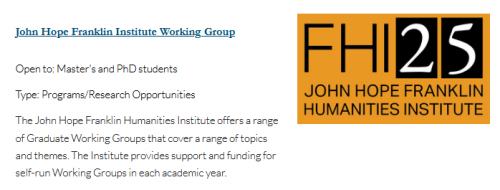
Our rationale for dividing the resources into four groups is a bit counterintuitive considering our goal of providing interdisciplinary resources. However, this choice came from careful thinking about how we could make the website efficient and easy to navigate, but also ask a central question driving the motivation for our project: “What academic disciplines do you want to branch out to?” For example, if you study physics and are hoping to branch outside your discipline, you can begin on the page with resources for those interested in humanities and social sciences.
These resources include those open to graduate students and postdocs. They also cover offerings such as funding, programs and research, and classes or academic opportunities. We have included the range of opportunities/resources that we came across in our preparation; however, the site is also designed in a way that will allow for additional information to be added.
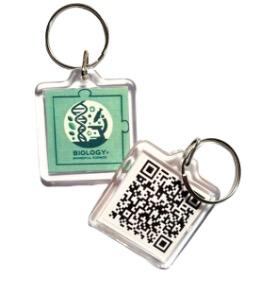
While Part 1 of our solution sought to address the lack of access to the range of interdisciplinary resources at Duke, Part 2 was concerned with awareness. As part of our strategy to spread awareness of the site, and boost awareness of interdisciplinary resources at Duke, we focused on creating promotional items that are both functional and visually appealing: a logo, stickers, and keychains.
The logo was designed to symbolize the unity of various academic disciplines, combining elements from sciences, humanities, and arts. This design represents the convergence of diverse fields into a cohesive image, reflecting the essence of interdisciplinary collaboration.
We chose keychains because they are everyday items that keep our message accessible and visible. Each keychain features our logo on the front for visual appeal and a QR code on the back for direct access to our online resources. This dual-purpose design ensures that the keychain is not only a decorative item but also a practical tool that facilitates immediate engagement with interdisciplinary resources.
Reflection
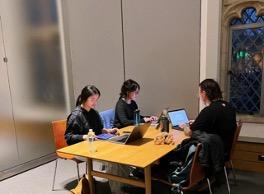
Interdisciplinary collaboration and communication are essential to developing as students and scholars. They also benefit and expand our understanding of the physical and social world. As such, graduate students and postdocs can benefit from opportunities to expand their horizons beyond the boundaries of their own fields.
The process of not only understanding and diagnosing the barriers that prevent access to these opportunities, as well as thinking through ways of addressing those barriers, gave us greater insight into the challenges of tackling these broad problems. We found that what we thought would be a successful idea at first would actually contribute to the very problem we were trying to solve. And once we settled on our approach, we were able to come together (as an interdisciplinary group ourselves!) to develop, design, and implement the ideas. We hope that the resources we developed will continue to have an impact on the ability of graduate students and postdocs to grow as scholars and researchers.
Authors

Edmund Handby, Ph.D. is a postdoctoral associate in the Department of Political Science. He completed his Ph.D. at the Australian National University in 2023. His research examines methodological questions in the history of political thought, empirically informed political theory, and politics, philosophy, and economics. His work has appeared in The Journal of Politics and The Journal of the Philosophy of History. He has also guest-edited a special issue on Jonathan Floyd’s “Is Political Philosophy Impossible,” out in Political Studies Review.
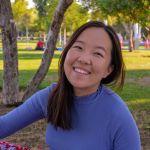
Odmaa Bayaraa is a third-year Ph.D. student in the Genetics and Genomics program (UPGG). As a member of the Gregory lab, she investigates the susceptibility of specific brain regions to Alzheimer’s disease using single-cell and spatial genomic methods. She is originally from Ulaanbaatar, Mongolia and received her B.S. in biology from New York University Abu Dhabi. Outside of the lab, she explores her passion for STEM outreach through programs like BOOST Beyond and DOinGG. In her free time, Odmaa enjoys painting and drawing, doing yoga, and climbing at the Wilson wall.

Qifeng Cheng, a second-year physics graduate student, bridges the realms of cosmology and art. From biomedical engineering to astronomy, her journey is fueled by interdisciplinary innovation. She leads research on dwarf novae, using data-driven models to unveil cosmic mysteries. Committed to merging diverse ideas, she’s passionate about starting an interdisciplinary club at Duke. Outside academics, she creatively merges her love for astronomy with artistic expressions like her “Harry Potter Astronomy” narrative and enjoys K-pop dancing. Her path exemplifies the synergy of scientific inquiry and artistic creativity, fostering unique insights and inspiring new perspectives.